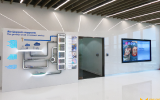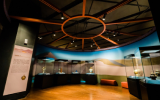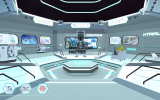From CX to DX: 4 Major Immersive Technology Applications in Brand Marketing
Catalog
- For brand marketing, what are CX and DX, and where do they differ?
- Successful examples of customer experience and digital experience respectively
- 1.Customer Experience - ANA: Every Brand-Related Moment Matters
- 2.Digital Experience - NASA: Turning Fans into Brand Ambassadors
- Why is Digital Experience Winning Out? 4 Major Immersive Technology Use Cases
- 1.3D Websites - Agile and Immersive, Mobile-First
- 2.AR Application for 1:1 Cross-Time and Cross-Location Showcase
- 3.VR Application, Immersive Virtual Reality for Ready Player One
- 4.AR Filters, Facial Recognition Enhancing Interactive Fun
- The best digital experiences come with six key advantages.
- Conclusion:Brand marketing should not only focus on customer experience; it should emphasize digital experience!

Source:Freepik
For brand marketing, what are CX and DX, and where do they differ?
For brand marketing, what are CX and DX, and where do they differ? HubSpot's founder Dharmesh Shah said, "Enhance the experience, more is better." How should brand marketing be carried out? This is no longer a good question. What you should ask is how to sustain the value of brand marketing in the hearts of customers. The devil is in the details. In this article, we will discuss how recent customer-centric experience journey design appeals to make marketing more humane. It may even leverage the power of technology to rediscover the emotions between people. This cannot be discussed without mentioning CX and DX.
Customer Experience (CX), or simply CX, encompasses everything that businesses or organizations do to put customers first, manage their journeys, and meet their needs, including providing the services that customers want and expect. Tailoring the experience to each customer achieves this effect. For a while, CX was considered everything! CX is essentially the experience journey that unfolds from offline touchpoints.
As for Digital Experience, often referred to as DX, it encompasses any comprehensive interaction between a customer and a brand, product, or service in a digital context. Due to the multitude of touchpoints between brands and customers, digital experiences can start on one platform and transition to others. For example, a customer may begin their journey on a website, then move to a mobile app, and finally conclude via email. Think about it – as a customer, digital behaviors can be quite complex. Digital experiences cover each of these interactions.
So, what is the relationship between Customer Experience (CX) and Digital Experience (DX)? Digital experiences influence the overall customer experience, and the personalized and consistent final experience is crucial. Digital experiences play a key role in the customer experience, determining whether customers are disappointed due to a cumbersome process or satisfied with a smooth, intuitive experience journey.
In simple terms, Customer Experience (CX) and Digital Experience (DX) are not the same. Digital Experience includes channels like websites, mobile applications, social media, smart devices, and more. Customer Experience goes beyond these channels but also encompasses them. You can consider Digital Experience as a subset of Customer Experience. However, with the accelerated digitization caused by the COVID-19 pandemic, the continuous increase in global internet usage, and the prevalence of mobile devices, Digital Experience has become a fundamental part of our lives. Coupled with the ongoing surge in e-commerce, Digital Experience is becoming increasingly important, often surpassing traditional Customer Experience in significance.
Turning personalized experiences into unique digital experiences to create greater value. According to a 2022 McKinsey survey, customers who have excellent digital experiences can generate three times the benefits.

Source:Freepik
Successful examples of customer experience and digital experience respectively
When you provide customers with a superior experience, they are more likely to buy more, become more loyal, and be willing to share their experiences with others, creating what is known as word-of-mouth marketing. This also leads to a well-functioning and cyclical marketing funnel, which is a goal pursued by every business with commercial needs. Non-profit organizations similarly need followers to build a better reputation in this "brand-centric" era. Next, I will share a successful example of CX (Customer Experience) and DX (Digital Experience) respectively.
1.Customer Experience - ANA: Every Brand-Related Moment Matters
One day, Eric Schwaninger and his family took a flight with ANA (All Nippon Airways). His child received a toy airplane as a gift, which brought immense joy. However, a few days later, the toy airplane got damaged. Eric wrote a letter to a friend in Japan, inquiring if there was a way to obtain another airplane toy. Surprisingly, two weeks later, ANA sent a letter all the way from Japan to Switzerland. In the letter, they not only apologized for the damage to the toy airplane but also included two new toy airplanes.
In reality, ANA didn't have to go to such lengths, but they provided a heartwarming service. This story comes from Eric, the Country Manager of Marketing Technology at Salesforce.
It illustrates the importance of ensuring that every passenger not only experiences exceptional service during the flight but also receives care and attention even after disembarking. Customer experience seems to be omnipresent. Eric emphasizes, "Valuing customer experience should not be limited to touchpoints between you and the customer but should also extend to crucial moments when the customer is connected to your brand." This is one of the many stories that have earned ANA recognition from its customers.

ANA is popular because its customer experience is pervasive, not just during the flight.
Source:King One Design
2.Digital Experience - NASA: Turning Fans into Brand Ambassadors
Even as a non-profit organization, NASA, the United States' space agency, is remarkably active. NASA extends customer experience to digital experience and started managing its media presence early on, placing significant emphasis on promoting science communication on social media.
When Twitter announced in 2008 that the Phoenix spacecraft had discovered water on Mars, NASA's account gained 75,000 followers. This marked the first step in building NASA's social media ecosystem with the goal of turning "NASA's fans into brand ambassadors." Today, NASA headquarters has an entire team of social media experts dedicated to managing its online presence. Its Instagram account alone boasts over 95.6 million dedicated followers, while related accounts like the Mars Curiosity rover have 4.269 million followers on Twitter.

Through managing a social ecosystem, NASA has successfully positioned itself as the most approachable science popularization brand.
Source:Freepik
Why is Digital Experience Winning Out? 4 Major Immersive Technology Use Cases
From offline customer experiences to digital experiences in social media, you can feel the core concept of 'customer-centricity.' However, it's time to delve into more advanced digital experiences, driven by the immersive experience revolution brought by VR and AR technologies, blurring the line between reality and virtuality. User digital experiences are about to determine everything!"
1.3D Websites - Agile and Immersive, Mobile-First
In the past, corporate websites were seen as potential marketing mediums, but now websites are considered the most crucial touchpoints between offline and online worlds. Upgrade your website! 3D websites are interactive and immersive, powered by advanced 3D modeling technology that transcends various media and efficiently responds to cross-device applications with agility. Users can freely navigate a 720° panoramic space on the website, combined with 3D modeling of products, showcasing physical products from all angles. In the face of such a digital experience, how can 2D web pages compete? Through digital experience mobile applications, seize every customer touchpoint, immersing people in the experience."

Combining 3D modeling with a 3D website makes the digital customer experience a key factor in the next step, whether it leads to a transaction or not.
2.AR Application for 1:1 Cross-Time and Cross-Location Showcase
Digital experiences are best when directly integrated with business sales. 'If the product doesn't fit in the bag, how can we market it?' King One Design's professional 3D design team utilizes modeling technology to create lifelike 1:1 machine models for Chin Fong Machine Industrial Co., Ltd. These models are combined with actual factory videos, presented in a bilingual design to simulate real-life situations. With just a smartphone or tablet, you can break through the limitations of time and geography, showcasing products to customers worldwide. This allows customers to gain a deep understanding of the equipment's features and functions, greatly enhancing convenience."

King One designed a complete one-to-one 3D model for the "Three-Dimensional Servo Transfer Device" of Chin Fong Machine Industrial Co.
3.VR Application, Immersive Virtual Reality for Ready Player One
Bringing online and offline customer experiences together is a significant aspect of VR technology. Virtual Reality (VR) is a computer-generated simulation where users can interact in a 3D environment using electronic devices like headsets, gloves, or hand-operated control consoles. When a user's physical presence is digitized, it allows them to experience a virtual world as if they were in the real world, providing a sense of immersion. VR applications primarily leverage visual and auditory technologies to enhance realism."

Using VR simulation to recreate the towing process, creating a lifelike towing mission experience.
Here are some key data findings of VR:
✓ A 2021 survey indicates that 84% of relevant stakeholders predict that virtual reality (VR) will surpass physical retail in customer experience planning within the next 5 years.
✓ The virtual reality (VR) market is expected to grow significantly from 2020 to 2024, with an estimated increase of $125.19 billion, at a compound annual growth rate (CAGR) exceeding 35% per year.
4.AR Filters, Facial Recognition Enhancing Interactive Fun
Whether it's for brand proposals, physical events, or the dissemination of owned media, SPARK AR filters are an excellent medium. AR, or Augmented Reality, offers an interactive experience that allows us to place digital objects into the real world environment. Many people may not be aware that common filters on social media apps are actually a form of AR technology. AR filters are the augmented reality versions for social media and are available on platforms like Instagram, Facebook, TikTok, and Snapchat. They are cost-effective, rapid, highly engaging, and have already garnered billions of users, changing our perception of real-life in a fun and interactive way.King One has designed custom-themed AR filters for many well-known enterprises and government agencies in recent years, including the National Palace Museum, Formosa Television, Taichung Bank, and the Central Engraving and Printing Plant, all of which are successful cases.

King One Design created fun AR filters for the Central Printing Factory's participation in the Asia International Philatelic Exhibition, enhancing the digital booth experience.
The best digital experiences come with six key advantages.
The integration of cutting-edge technologies into digital experiences is revolutionizing audience perception and innovating the customer journey. A brand can track interactions across multiple channels, and well-designed digital experiences can:

Excellent digital experiences increase customer retention in fierce competition.
Source:Freepik
(1) Meeting Customer Expectations: Everyone's familiarity with technology may vary, but they all expect experiences to be innovative, consistent, personalized, and efficient. This also helps build brand recognition.
(2) Building Brand Loyalty: Every brand may have a website and app, but not every brand can provide the best service to customers. Exceptional digital experiences increase customer retention in fierce competition. The 80/20 rule, achieving more with less, is an eternal golden rule and one of the highlights of this article.
(3) Cross-Border Customer Interaction: With the support of digital channels, digital experiences can transcend geographical boundaries, providing services wherever each customer is located, showcasing the brand's accessibility.
(4) Gaining Data Insights: Digital experience touchpoints can systematically provide data on behaviors and preferences, which also determines the direction of digital marketing strategies. This allows companies to make decisions based on data and adjust products, services, and experiences.
(5) Cost-Effective Operations: Managing and operating digital channels is often more cost-effective than traditional marketing methods, enabling companies to optimize resources and achieve better return on investment (ROI).
(6) Increasing Revenue: Many studies have confirmed that digital experiences can drive higher conversion rates, resulting in sales growth.
Conclusion:Brand marketing should not only focus on customer experience; it should emphasize digital experience!
Through innovative immersive solutions, practice digital transformation through digital experience (DX), transforming customer experience (CX) into digital experience. In brand marketing, let's not just talk about customer experience; let's talk more about digital experience!
Connecting the entire digital journey, crafting personalized experiences into unique digital experiences, creating greater real-world value, and using immersive technology to rethink and reshape 5-star digital experiences.

Source:Freepik
- 1
6 Different Types of Trade Show Booths You Need to Know
Brand Strategy
- 2
What is CIS? Corporate Identity Design that goes hand in hand with exhibition design
Tech Life & Trends
- 3
Introduction of 3D Logo
Exclusive Perspective
- 4
3D Logo - The Little Secret in Exhibition Design
Exclusive Perspective
- 5
What you need for Situational Design - 2.5 D
Exclusive Perspective
- 6
What is the definition of Experiential Marketing? From 5 perspectives, you will get it!
Tech Life & Trends











The web response time is commonly referred to as TTLB (Time to Last Byte).